Term archive
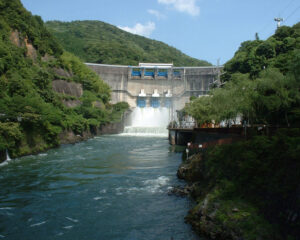
投稿タイプ:sightseeing
Amagase Dam
This multipurpose dam was completed in 1964 with the aims of flood control, electricity production, and water supply preservation. With a height of 73m and a length of 254m, the imposing Amagase Damn is an arch dam built in a dome shape. From the top of the dam, you can look out over the lake at its top, nicknamed the "Phoenix Lake," on whose surface the different colors of the seasons are reflected.
The Phoenix Lake is so named because it resembled the shape of the birds spreading their wings to fly further downstream, and also with the hope that people will be able to create a kind of paradise (with which phoenixes are associated) on earth.
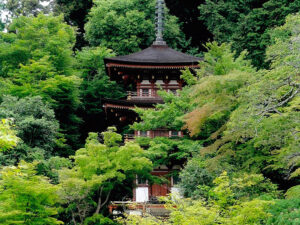
投稿タイプ:sightseeing
Joruri-ji Temple
Joruri-ji Temple, located in the "Kyoto Infused with Tea" region, is a temple of the Shingon Ritsu Buddhism (Nara sect) that holds 4 national treasures and 9 important cultural properties.
According to the records of the temple, the temple was opened in 1047 by Yoshiaki Shonin and enshrines the “Yakushinyourai,” the Buddha who can cure all illness. The name of the temple is said to come from "Joruri," the realm where the Buddha lives.
The main hall of Joruri-ji is particularly long with nine Amida Buddhas enshrined inside. During the Heian period about 30 such nine-body Amida temples were built around Kyoto, but Joruri-ji is the only temple that still exists. Both the main hall and nine-body Amida Buddha are designated as national treasures.
*The Nine Amida Buddhas sitting statues are being repaired two at a time over a five-year period from July 2018.
To the east of the main hall is a garden containing a three-storied pagoda and Yakushinyourai Buddha statue arranged around a pond. The layout of the grounds is said to be in the shape of the Sandskrit letter "A," expressing paradise.
Surrounded by abundant nature, the temple has also has been designated as a special national scenic spot. You can enjoy beautiful scenery throughout the year, and the road connecting Gansen-ji and Joruri-ji is called the "Stone Buddha Road," and there are many stone Buddha statues make it the perfect place for hiking.
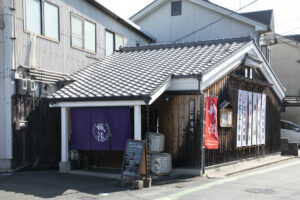
投稿タイプ:sightseeing
Joyo Shuzo
Founded in 1895, Joyo Shuzo produces sake and plum wine.
The brewery's representative brand is its Junmai Daiginjo Joyo sake, and plum wine. Its representative plum wines, "Hanakoeda" and "Umekoeda," use only local aodani plums, and are aged for over three years and prepared without added coloring or flavoring.
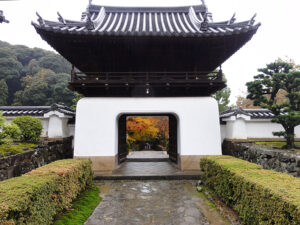
投稿タイプ:sightseeing
Kosho-ji Temple
This temple of the Soto Zen school of Buddhism was a training hall opened in Fukakusa (Fushimi) by the Buddhist monk Dogen in the Kamakura Period (1192-1333). It was later reconstructed in 1648 by Lord Nagai Naomasa of Yodo Castle, using the remains of Fushimi Castle. Highlights amongst the seven structures in the temple grouds include the Kotozaka, the approach to the temple that forms a tunnel of fall foliage in autumn; the temple gate made in the Ryugu-zukuri architectural style; “nightingale” hallway floors that squeak to alert those within of intruders; the Tenarai Kannon bodhisattva as mentioned in the classic "The Tale of Genji"; and chitenjo ceilings.
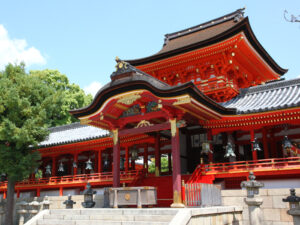
投稿タイプ:sightseeing
Iwashimizu Hachimangu Shrine
One of the three main shrines bearing the name Hachimangu, Iwashimizu Hachimangu Shrine was dedicated to a god for the protection of the nation in 860. After the main shrine was restored by Oda Nobunaga and its cloister rebuilt by Toyotomi Hideyoshi, Tokugawa Iemitsu built an additional ten shrine buildings in 1634, all of which are a part of this National Treasure.
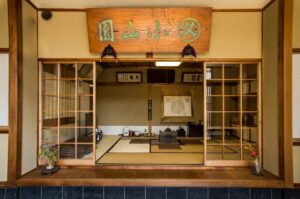
投稿タイプ:sightseeing
Marukyu Koyama-en
Kujiro Koyama began cultivating tea here in the Genroku era (1688-1704). After four generations, the family expanded into sales, and after eight generations they expanded their market to reach across Japan. Even now, continuing 300 years after its establishment, they continue to make tea with a focus on flavor and safety, with "quality-oriented tea production" as their guiding principle. Everything from cultivation to production is done in-house, and in order to continually improve the quality of their teas, they also frequently enter their products into tea competitions. As a result, they have made the prestigious achievement of receiving the Ministry of Agriculture, Forestry and Fisheries' Award.
Marukyu Koyama-en's wide lineup includes matcha tea, high-grade gyokuro tea, and sencha tea, as well as matcha-flavored sweets and beverages.
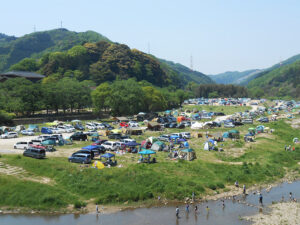
投稿タイプ:sightseeing
Kasagi Camping Ground
Kasagi Campground is located in southern Kyoto prefecture along the Kizu River. The campground has over 30,000 sq. meters of camping space and is easily accessible from Kyoto, Osaka, and Nara. Same day reservations are allowed and the affordable price make it an excellent spot to get way from the city and relax.
The campground offers: Kitchen facilities, western style toilets (please bring your own toilet paper) and garbage sites. Showers can be found at several nearby locations including Kasagi BBQ Company M5 (300 yen per 15 mins) near the campground entrance and Shimagahara Onsen “Yabuccha” around a 20 minute (15.7km) drive from the campsite.
The campground has lots to do besides camping. You can swim in the river, go canoeing, rocking climbing, or fishing. The most popular activity, however, is having a barbeque next to the river. Barbeque sets can be rented but open fires are also allowed. In spring, the campground’s Sakura trees bloom and you can camp under the Sakura blossoms. In summer, the clear night sky is perfect for star gazing.
Kasagiyama National Park is also located nearby. The park includes hiking trails, interesting rock formations, and historic sites and temples of national importance. It is the perfect place to spend the day before camping overnight.
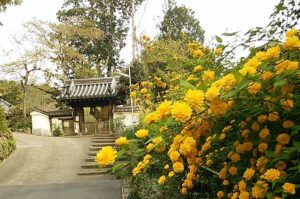
投稿タイプ:sightseeing
Eshin-in Temple
Eshin-in Temple is also known as the "Temple of Flowers," and in spring and autumn, the garden becomes home to vast swathes of flowers that soothe the heart and calm the mind. Tradition has it that the temple began as the ancient temple of Ryusen-ji. Some time later, it was restored by the monk Genshin (Eshin Sozu), renowned as the author of the text "Ojo Yoshu" ("The Essentials of Rebirth in the Pure Land").
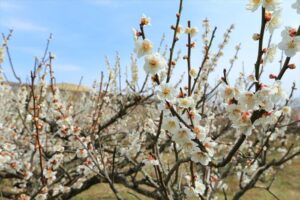
投稿タイプ:sightseeing
Aodani Plum Grove
Commanding a distant view of the holy mountain Jubo, the Aodani Plum Grove spreads out over the gently sloping hills bordering the crystalline Aodani River. The 20-hectare plum grove has been reknowned as a scenic spot since olden times. Its 10,000 plum trees are mainly of white-blossomed varieties, such as the large and fragrant Joshuhaku, Joyo City's plum species. The Plum Festival is held every year from late February to late March.
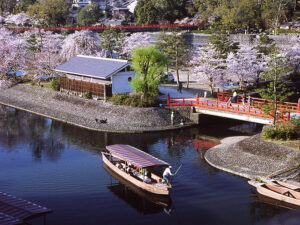
投稿タイプ:sightseeing
Uji River Islands Tonoshima & Tachibanajima
Tonoshima and Tachibanajima Islands are collectively called Nakanoshima (islands in the middle of the river). There is a beautiful 13-story pagoda around 15 meters tall on Tonoshima. It was built in the Late Kamakura period (1192-1333) by the monk Eison, of Nara's Saidai-ji Temple, to pray for the souls of fish. The pagoda, which was buried by the river in a flood in 1756, was rediscovered and rebuilt towards the end of the Meiji period (1868-1912).
The flood levees are famous for the cherry trees that flower there. In early April, the Ujigawa Cherry Blossom Festival is held on the island, which has now become a park.
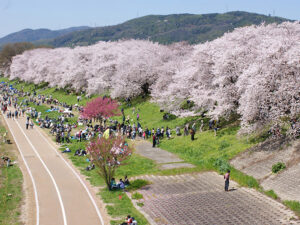
投稿タイプ:sightseeing
Yodo River Park Sewaritei District
This park is located to the north of Iwashimizu Hachimangu Station on the Keihan Line, just across Goko Bridge. Here, you'll find a line of cherry blossom trees that extends for about 1.4 kilometers. The trees were planted at the separation levee where the Kizu-gawa and Uji-gawa Rivers merge, forming a band of flowers in early April. The surrounding area is a riverside park with a large lawn and a lookout area.
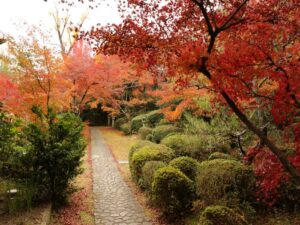
投稿タイプ:sightseeing
Zenporitsu-ji Temple (Maple Temple)
Zenporitsu-ji Temple, located in the southeast of Iwashimizu Hachimangu Shrine in Yawata City, Kyoto, was donated by Zenpoujikyusei, the officer of Iwashimizu Hachimangu Shrine, in 1257 as a dormitory for the monks. Jissou-Shonin, a master from Todai-ji Temple in Nara, was invited to be the founder of the temple.
It is said that Ryoko, the great-granddaughter of Zenpoujikyusei, married Ashikaga Yoshiakira and gave birth to the third generation Shogun Ashikaga Yoshimitsu, and was deeply tied to the Muromachi Shogun family.
Many maple trees (momiji) donated by Ryoko are planted in the gardens, and in autumn, nearly 100 maple trees turn red, creating beautiful scenery that has earned the temple the name of “Momiji Temple.”
The main hall and the front gate are designated as cultural assets of Kyoto Prefecture. In addition, the temple has a total of 9 designated cultural assets of Yawata City, such as its seated statue of Amida Buddha (Amida Nyorai) with jewel crown and the seated statue of the Yawata Buddhist monk (Reservations are required for visits of the interior of the main hall).